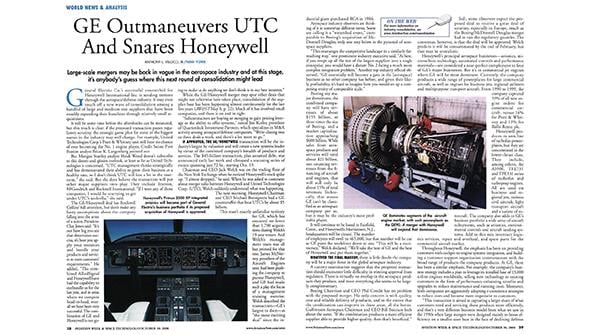This article is published in Aviation Week & Space Technology and is free to read until Apr 27, 2024. If you want to read more articles from this publication, please click the link to subscribe.
Opinion: Five Blockbuster Aerospace Mergers That Never Happened

On June 10, 2019, Greg Hayes and Tom Kennedy, then chairmen and CEOs of United Technologies Corp. and Raytheon, respectively, announced an unprecedented $135 billion merger of equals. As a result, Raytheon Technologies, later renamed RTX, became an aerospace and defense industry giant with $74 billion in combined revenue and 195,000 employees. Longtime industry watchers were astonished at the size of the deal, which remains the largest aerospace merger and acquisition (M&A) transaction ever, combining previous industry stalwarts Raytheon, UTC, Goodrich, Rockwell Collins, B/E Aerospace and Hamilton Sundstrand under a single corporate umbrella.
Prior to the Raytheon-UTC merger, the prevailing wisdom among analysts was that a transaction of such size was not possible due to antitrust concerns or national interests. In fact, many ambitious M&A deals in aerospace have gone by the wayside during the past 25 years. Five in particular, amounting to over $200 billion in total enterprise value, stand out. Had they happened, the industry today would be almost unrecognizable.
(1) In 1997, Norm Augustine, then chairman and CEO of Lockheed Martin, announced the proposed $11.6 billion acquisition of Northrop Grumman. The resulting entity would have had $37 billion in revenue and 230,000 employees. The U.S. Justice Department, with strong support from the Pentagon, filed suit in U.S. District Court to block the transaction, as the combined company would have accounted for 28% of the Defense Department’s procurement and research, development, test and evaluation budget. The deal was called off eight months later as “tension was rising with our biggest customer,” said Vance Coffman, Augustine’s successor.
(2) In 2000, Jack Welch, then chairman and CEO of GE, launched a last-minute $49 billion bid to acquire Honeywell International. GE’s bid topped UTC’s $40 billion offer, which Honeywell was on the cusp of accepting. The GE-Honeywell entity would have combined revenue of $155 billion and 460,000 employees. Due to unexpected rejection by the European Commission, GE and Honeywell terminated their merger agreement, even though it had been approved by the Justice Department.
(3) In 2007, French daily La Tribune reported that Thales and Safran were preparing to restart on again/off again merger plans. The pairing would have created the second-largest global aerospace equipment supplier after GE, with annual sales of $34 billion. In its quest to create French global aerospace and defense industry leaders, the French government reportedly encouraged EADS (now Airbus) to acquire Thales in 2004. But neither happened.
(4) In 2012, EADS and BAE Systems announced a $48 billion merger. Under the proposed agreement, EADS shareholders would have owned 60% and BAE shareholders 40% of the merged entity. The combined company would have had $90 billion in revenue and 220,000 employees. However, the proposed merger of the UK’s largest defense contractor with EADS drew the attention of European governments eager to protect their respective national interests. The UK and French governments gave tacit approval, but Angela Merkel, then German chancellor, was “philosophically opposed” to the transaction, which led to its eventual collapse.
(5) In 2016, Honeywell announced a $90.7 billion merger with UTC, comprising $35.8 billion in cash and $54.9 billion in Honeywell stock. The combined company was expected to generate $3.5 billion in cost synergies and $97.1 billion in annual sales. Hayes, then UTC chairman, firmly rejected the deal, stating that the offer “grossly undervalue[d]” UTC, overstated potential synergies and would simply have not been allowed by regulators.
From the above, a few observations are discernible:
• National interests in Europe have continued and likely will continue to thwart cross-border conglomeration.
• The U.S. Defense Department appears to be firmly opposed to outsize contractor power.
• While grandiose couplings in commercial aerospace might appear less problematic from an industry perspective, aggrandizing moves are likely to raise strong antitrust concerns in the U.S. Justice Department.
Numerous OEMs and prime contractors have tried and failed to acquire or merge, creating antitrust fault lines that will be difficult to cross. Whereas then Deputy Defense Secretary William Perry famously advocated for consolidation among defense primes at the 1993 “Last Supper,” the Pentagon now is trying to keep its supply chain intact, seeking more independent companies at the table. The likelihood of a transaction comparable to Raytheon-UTC going forward remains remote.
Investment banker Stephen Perry is managing director at Janes Capital Partners in Irvine, California.




